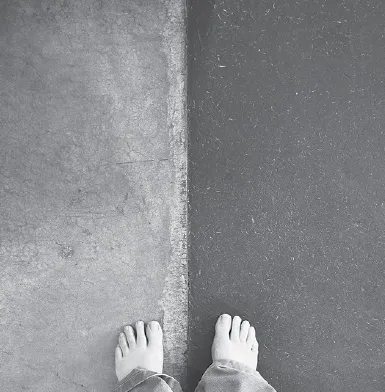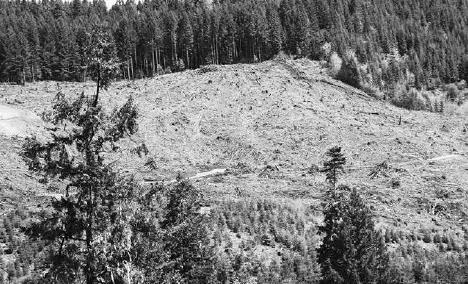![]()
SECTION 1
ABOUT EARTHEN FLOORS
The idea of living on a floor made of earth is not new; humans have been doing that for centuries. What is new is the idea of bringing these ancient materials into our modern homes. It is valuable to understand where the techniques used today came from, and how earthen floors are different from (and similar to) other flooring options, in order to make sure they are installed in appropriate settings.
JAMES THOMSON
MIRI STEBIVKA
![]()
CHAPTER 1
The History of Earthen Floors
BUILDING WITH EARTH HAS BEEN A STAPLE OF HUMAN CIVILIZATION for millennia. Confronted with the question of how to shelter themselves, our ancestors looked around and found an abundance of natural building materials right under their feet. Using soil, sand, rocks and plant fibers, they built durable and comfortable buildings that would stand for generations. They used these same materials to add smooth, attractive finishes, providing bright, beautiful and durable interiors and exteriors. For most of human history, people have lived in houses that they (or a family member) had built from materials found close by. In many parts of the world, these ancient traditions are still in use today.
600-year-old “Hakka” communal earthen structure, China.
(CREDIT: © LIUMANGTIGER | DREAMSTIME.COM)
Earth is abundant and ubiquitous. Trees don’t grow everywhere, but the earth is always underfoot. There are several earthen building techniques that readers may be familiar with. The most widely known is sun-baked clay bricks, often referred to as adobe. There is evidence that ancient Egyptians made mud bricks more than four thousand years ago (2000 BCE). Every continent on Earth has ancient structures built from mud or clay bricks. Here in the US, there are many examples of ancient adobe buildings, including the oldest continually occupied structure in North America: Taos Pueblo in New Mexico, about a thousand years old. Other common earthen building techniques are waddle and daub (mud plaster smeared over a matrix of woven sticks), cob (similar to adobe, but without the bricks) and sod (bricks of earth and roots cut from the earth). Earthen plasters, sometimes mixed with manure and natural pigments, have been utilized to beautify and preserve earthen dwellings. Human societies the world over have employed these (and similar) techniques for thousands of years to create shelter. And these techniques are still in use today; it is estimated that a quarter to a third of the world’s population lives in houses built partially or entirely of earth.1
During the industrial revolution and the population (and building) boom that followed, many of these traditional techniques were displaced by new materials and building designs, such as lightweight wooden structures framed with wooden studs that could be erected quickly and cheaply. A new industry of building product manufacturers arose to satisfy the insatiable demand for more houses. By “outsourcing” much of the materials preparation to these manufacturers, buildings could be built even faster.
This once-new paradigm has become the standard in developed nations. Building products manufacturers, from lumber companies to paint companies, continue to make and sell products that allow buildings to be completed in a fraction of the time it would have taken our ancestors just three or four generations ago.
Wooden stud framing in progress.
(CREDIT: © PICSTUDIO | DREAMSTIME.COM)
Scars on the landscape left behind by logging operations.
(CREDIT: © STEVE ESTVANIK | DREAMSTIME.COM)
Yet this time saving has a cost: not only a financial cost but also a cost to the health of our planet and our bodies. The buildings industry is one of the most destructive forces on the planet, producing toxic chemicals that we are encouraged to put in our homes (paint, wood treatments, formaldehyde, glues) and leaving vast swaths of clear-cut or strip-mined land in its wake.
Buildings Are the largest contributor to climate change
(adapted from Architecture 2030: Climate Change2)
According to the US Energy Information Administration (EIA), the building sector consumes nearly half (48.7%) of all energy produced in the United States, about the same amount of energy consumed by transportation (28.1%) and industry (23.2%) combined. Globally, these percentages are even greater. Most of this energy is produced from burning fossil fuels, making the building sector the largest emitter of greenhouse gases on the planet — and the single leading contributor to anthropogenic (human-created) climate change. Nearly half (46.7%) of all CO2 emissions in 2009 came from the building sector (transportation accounted for 33.4% and industry just 19.9%). With so much attention given to transportation emissions, many people are surprised to learn these facts.
The environmental impact of a building doesn’t end when the last contractor leaves the building site, either. As the evidence for climate change becomes overwhelming, the calls for changing the status quo are growing louder.
This book is not intended to address all of these challenges, but it does pose a possible answer to the question “Is there a better way?” The Earth provides an incredible abundance of durable, non-toxic and beautiful building materials that can be found almost anywhere. Our ancestors knew this. Can we learn, again, how to use them?
The rise of “green building”
In the 1970s, rising awareness of environmental pollution coupled with an energy crisis spurred the growth in North America of what has come to be known as the green building movement. Green builders strive to improve the energy efficiency of new buildings and to use materials that are less toxic and more sustainably produced. Adhering to the philosophy that the “greenest” building is the one that is already built, they also work to retrofit existing structures for improved energy efficiency as well as creating spaces that are more pleasant to work and live in.
A whole industry has arisen to address the concerns of those who struggle with the destructive nature of the conventional construction industry. Green building, from whole building design to remodeling materials, is on the rise.
Natural building
“Natural building” is a relatively new term that describes a building philosophy that emphasizes sustainability through using min...






